Maksim Mrvica North American Tour Concluded in New York City
May the 28th, 2023 - The Maksim Mrvica North American tour concluded in New York City on Saturday. This was otherwise the first North American tour by the renowned Croatian classical crossover pianist who enjoys international recognition.
New Yorkers, including a lot of Croatian Americans and their friends, enjoyed an evening of unforgettable music as virtuoso pianist repeatedly caused stormy ovations from the cheering audience. New York concert took place in the United Palace, which is Manhattan’s 4th largest theatre featuring a distinctly unique fusion of decorative styles and symbolic motifs.

Maksim, who has made a famous name and reputation over the last two decades with his curated collection of crossover performances, started his North American tour on May 17th in Vancouver, followed by concerts on May 19th in Toronto, May 23rd in Seattle, and May 25th in Chicago.
With a crossover show, 'The Collection' showcased the greatest hits of all time by Coldplay, John Legend, and Queen, themes from movies like Godfather, Pirates of the Caribbean, Game of Thrones, some classical masterpieces by Liszt and Chopin along with the biggest pieces from his previous ten albums like Flight of the Bumblebee, Exodus and many more. Maksim performed with his full band and brought to North American audience a dazzling, overwhelming performance.
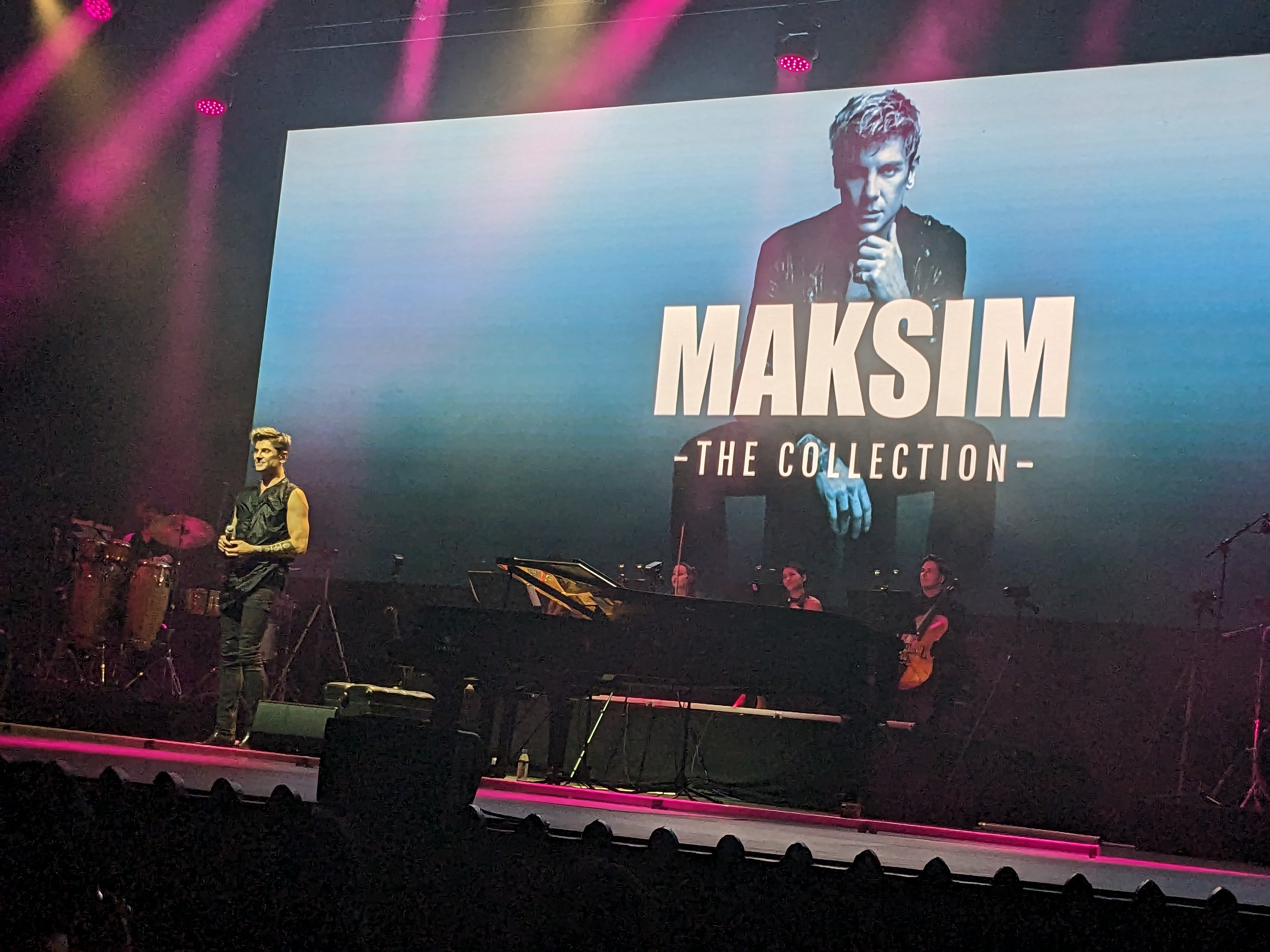
After a pause of almost 3 years, he started the world tour ‘The Collection’, which began in Australia in September last year, followed by tours in Asia, Europe, and in North America. It’s been more than 20 years since he started to play crossover music. During these years he has recorded 10 studio albums and with this tour ‘The Collection’ he has chosen some of his most popular and famous pieces to perform together with the band, all around the world. When performing crossover shows, he uses the opportunity to play one or two pieces from his classical repertoire. For this tour, Maksim has chosen Liszt Ballade No.2.
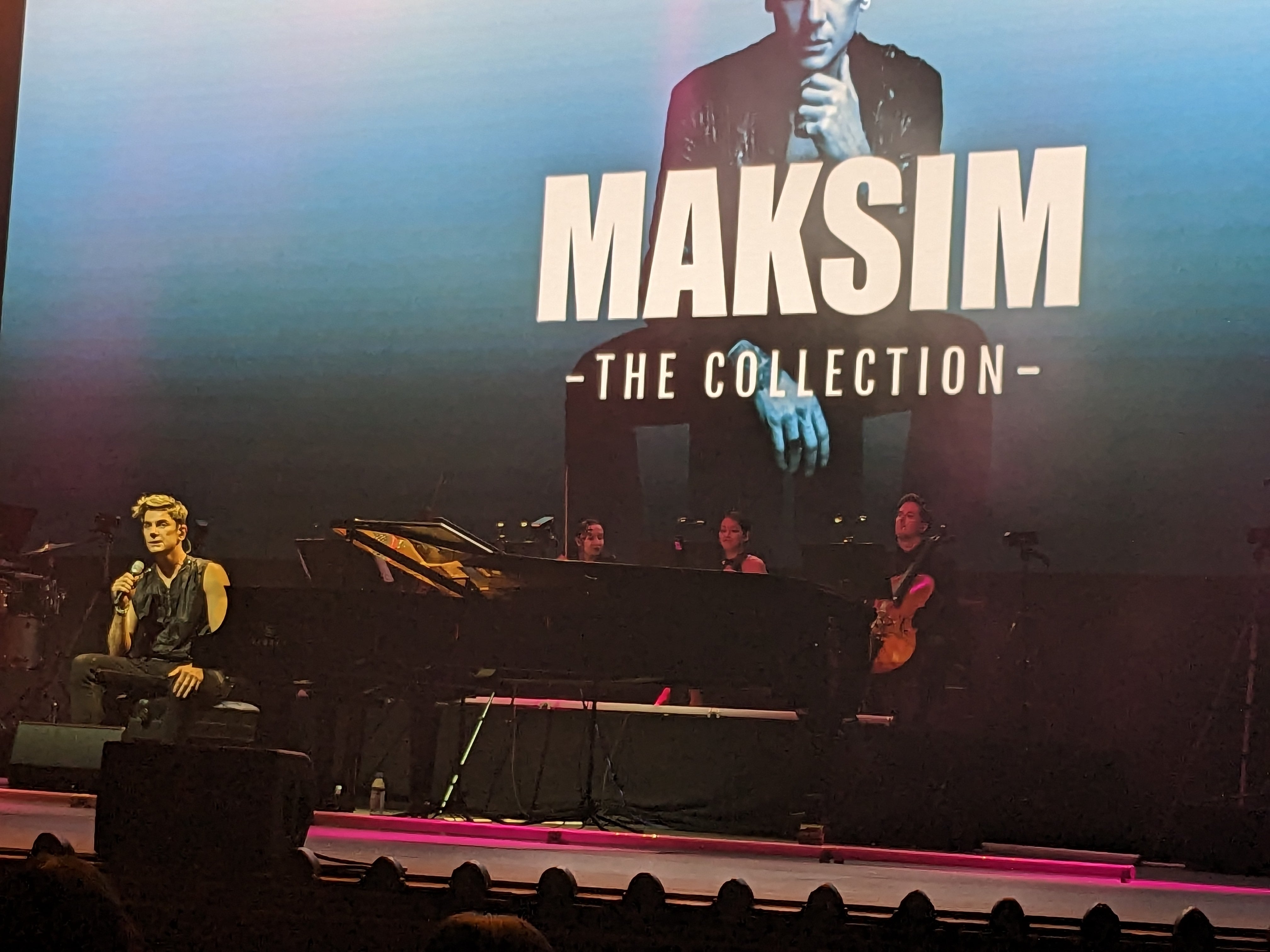
Maksim was born in Šibenik, Croatia, and has received numerous accolades for his music, including an MTV Award and a double-platinum album. He is currently in the process of recording a new album. He has already recorded a new song and now work on choosing and recording some new pieces for his next album, which is expected to be released by the mid of 2024.
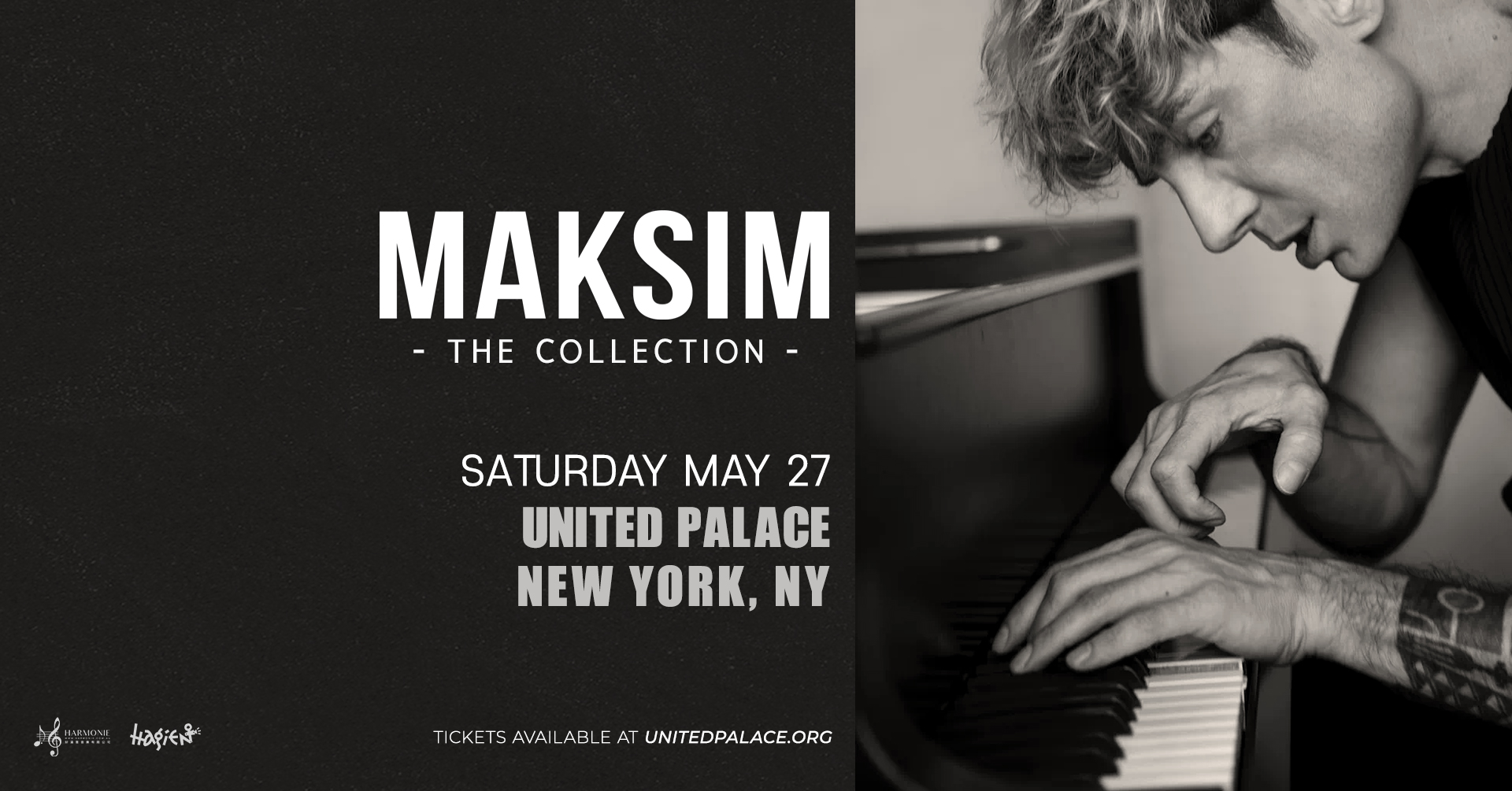
Silvio Bilić: Croatia's Classical Guitar State Competition Winner and 4-time Oscar of Knowledge Recipient
June 12, 2021 - Europe is a dream destination for artists and musicians and Croatia is certainly keeping up with the excellent European art scene. Although best known for being a holiday destination, Croatia also boasts world-class academia, professors, artists, and performers, too! TCN meets Silvio Bilić.
Silvio Bilić and the town of Omiš
At the young age of 23, Silvio has already won 34 first prizes for national and international competitions, is a four-time recipient of the Oscar of Knowledge from the Croatian Ministry of Science, Education, and Sports, and a 4-time state champion of Croatia's Classical Guitar State Competition. Currently a student at the Academy of Arts in Split, under Prof. Maroje Brčić, his path to music excellence all began at the age of 8 in a small town of Omiš in the region of Dalmatia.
What inspired you to be a guitarist?
I started playing the guitar at the age of 8 - which was quite late for someone who wishes to pursue classical music - but fortunately, I exhibited good potential even as a beginner. I spent the first four months of my early education competing and I ended up in the top 3 young artists of my generation. I chose the guitar as my instrument because it is one of the most celebrated and known instruments in the region of Dalmatia where it is a common sight to see people sing and play guitar. One day, I saw my cousin playing and handling the guitar so eloquently and after that, I had a strong desire to try so that I could feel the elegance of playing the instrument myself. The first time I played the guitar, I felt an immediate connection to it and that was when I discovered my life goal - to be a professional guitarist and performer.
What was it like to be a young musician in a small town?
Growing up in a small community actually helped me a lot because since the town is small, the engagement and the involvement of the people in our town towards classical music (arts scene, in general) and the local artists are very focused. Because of this, the talents of their youth are recognized early and are highly encouraged by the community.
How do the people in Omis perceive arts and support you as a budding artist from their hometown?
The people of Omiš are very supportive especially towards my goal which is to present to the younger and older generation that there is a career and profound satisfaction in pursuing the arts, especially music, and to remove the stigma that arts are just a hobby. Omiš Centre for Culture (Centar za Kulturu Omiš) helps me realize this goal by organizing my honorary concerts in Omiš and helps in promoting it as well. They make posters and also arrange collaborations with local drama artists, painters, and photographers. In Omiš, there are two stunning performance venues which are my favourites (although we have a lot in Omiš) - The Church of Holy Spirit and The Church of St. Peter.
What were your early years of music studies in Omiš like?
After enrolling at Osnovna Glazbena Škola Lovro pl. Matačić Omiš when I was 8 years old, I discovered that with the guidance of great mentors, I could pursue music professionally and make a great career out of it. My first-ever professor was Neno Munitić who introduced me to guitar and the endless opportunities in the world of art. The first piece I learned and performed was from an etude from a classical composer Fernando Sor. For my first competition, I played this same piece with an addition of an original piece by Prof. Neno which was called December Morning, and coincidentally enough (I took it as a sign that I was on the right path) - I was born in December! Throughout my early music education, I did a lot of chamber music to understand music from a deeper and wider perspective. As years go by, with solo and chamber music training, I've grown as a more defined musician and by the age of 10, I travelled to Italy for my very first competition and won first prize. From then on, I have performed and competed all over Croatia and Europe but I've never forgotten my hometown. At least once every summer, I make sure to organise a concert in Omiš. In 2017, I passed the entrance exam and audition for the Academy of Music in Split, Croatia, and I have been studying under the tutelage of Prof. Maroje Brčic since then.
Series of National and International Competitions
Since my first international competition at the age of 11 in Italy, I have been given the opportunity to travel to Italy, Germany, Bulgaria, and North Macedonia. The most memorable one I have ever done was the International Competition for Young Guitarists "Andres Segovia" in 2014 in Germany with 50 competitors under my category who were all working with outstanding and well-known guitar professors and world-renowned music schools such as The Julliard Music School, USA and The Royal Academy of Music, UK. After the performance, I was standing on the stage with 49 other competitors as the jury announces the winners starting from the last place to first place. After what seemed to be an eternity, my name has not been called and my heart began to pound tremendously because I did not expect that I would qualify for the top prizes since I came from a small country, school, and community. Surprisingly, I ended up winning 4th prize! My career in music competition started to take off after this.
Ever since 2008 to the present date, I have consistently been winning the first prize every year! So far I have won 22 first places in the solo performance category and 12 first places in the chamber music category. In 2017, I won 1st place in the National Guitar Competition (HDGPP) followed by 2019, after defending the title of national champion once more. In 2021, I again won the title of state guitar champion competition (HDGPP), 1st prize, in the senior category. In 2014, 2017, 2019, and 2021, I was awarded the "Oscar of Knowledge" by the Ministry of Science, Education, and Sports for excellent results in the national competition as a soloist and as a member of the chamber ensembles.
Since I began learning the guitar, I have been competing a lot (which I love), but by the beginning of 2016, I had to take a different approach in music after I collapsed in Prague and was diagnosed with arrhythmia which I was completely oblivious to. The doctor reckoned that it worsened due to extreme stress and I have had to live with a pacemaker since this incident. From then on, I shifted my "competition approach" to music towards a more relaxed and enjoyable "concert approach". I began attending various masterclasses with world-famous pedagogues and guitarists and performed as a guitar accompanist in many book promotions and recitations. I also have had opportunities to collaborate with famous drama artists Robert Kurbaš, Ksenija Prohaska, and Otokar Levaj.
Winning Eurostrings competition in Montenegro and 2020 Europe tour
In 2020, I was selected among the top 17 young guitarists in Europe in the Eurostrings program under the auspices of the EU creative program, and was awarded a concert tour in the Netherlands, Italy, Spain, Sweden, and the United Kingdom and a personal web domain. Unfortunately, due to the COVID-19 pandemic, the tour was postponed. I instead provided concerts to London Guitar Festival and Mottola Guitar Festival in Italy, masterclasses for Twents Guitar Festival in the Netherlands and a concert, TV promotion, and masterclass in Nikšić Guitar Festival in Montenegro. I had my biggest concert in Uppsala, Sweden, where the tickets sold out! I remember being thrilled to see a large projection of my upcoming concert outside a building and to give press conferences about my performances in Europe - I even had a personal guard to accompany me throughout my concert for the national television in Sweden! I also collaborated with maestro/conductor Christian Karlsen and Grammy-nominated Royal Academy of Stockholm professor, Mats Bergstrom. Together with students from the University of Malmö, I had the honor to premiere a piece by composer Sergio Assad entitled The Walls. It is a 5-movement piece for solo guitar and guitar orchestra which depicts historical barriers to migration and cultural assimilation in the world in each of its movement: from 1st to 5th movement - The Great Wall of China, Hadrian's Wall, The Berlin Wall, Middle Eastern Wall and finally, No More Walls.
Arts in Omiš
In Omiš, we have one of the most famous and traditional festivals in Croatia. It is called "Festival Dalmatinskih Klapa" or Festival of Dalmatian A'ccapella Music. Since its founding in 1966 by a group of enthusiasts from the city who aim to preserve this Croatian traditional singing-style "klapa", over 200 groups, famous musicologists, and composers from across Croatia have performed and attended the festival. The festival was even added to UNESCO Intangible Cultural Heritage Lists. in 2013.
There is also an abundance of excellent musicians, artists, and mentors in my hometown. For example, we have Lovre Marusić who was born in Omiš and began his music career here before continuing his further studies in prestigious schools such as the PI Tchaikovsky State Conservatory in Moscow, Russia, Academy of Music in Zagreb, Croatia, and currently at the Hochschule für Musik “Franz Liszt” in Weimar, Germany for postgraduate studies. He has also won several first prizes from international competitions such as the reputable IMF Internationa Piano Competition in Paris (2018) and International Piano Competition "New Stars" in Manchester (2016), to name a few. Lovre Marušić is also very connected to the young artists of Omiš with a lot of them viewing him as an inspiration in their pursuit of the arts.
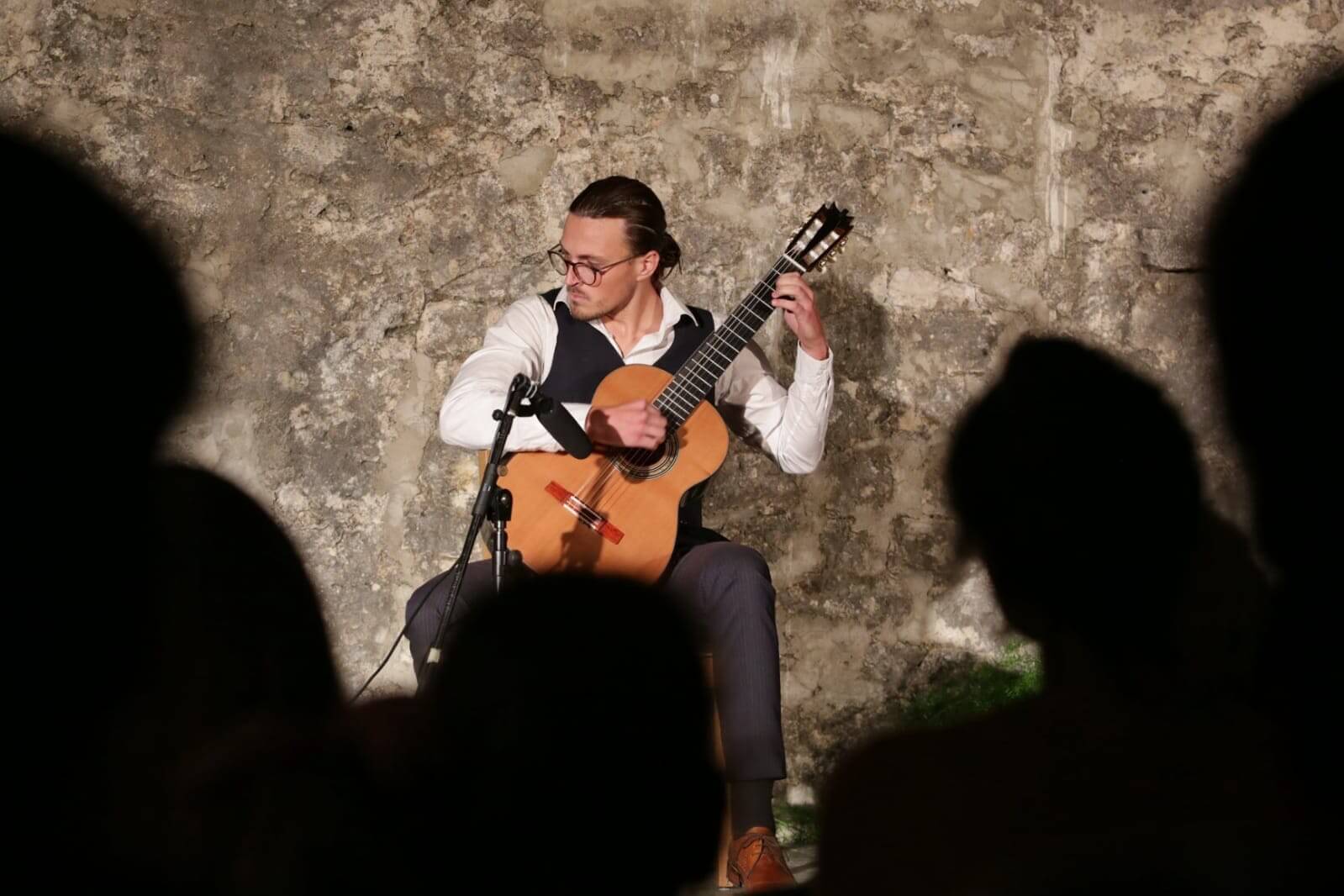
Photo credit: Zvonimir Kujundžić
Arts in Croatia
Croatia has a very natural affinity in art because the country itself is beautiful - starting from the glorious southern city of Dubrovnik towards the capital city of Zagreb, the country boasts raw culture and beauty everywhere and that is why it is one of the most popular destinations in Europe. In Croatia, any contribution to arts is highly celebrated, and even in small towns like Omiš where arts and its promotion to the community have substantially grown and the support to the local young artists is significant. Since Croatia is small, its artists and musicians are rarely seen in international competitions but once they do, they deliver outstanding performances and consistent excellence in their craft. A lot of Croatian musicians and artists easily qualify to bigger conservatories, schools, and academies all over the world. Croatia is also popular not just to Erasmus exchange students but also to students from all over Europe who come to Croatia to seek established professor that is now teaching and living here.
For more about made in Croatia, follow TCN's dedicated page.
For more about Croatia, CLICK HERE.
VIDEO: 200 Croatian Musicians Perform Unifying Favourite at Bundek
February 23, 2021 – In uplifting scenes filmed on Lake Bundek, Zagreb, 200 Croatian musicians gathered to record a unifying rendition of beloved Croatian hit 'Za ljubav, Treba imat dušu' (For Love, You Need To Have a Soul) by Atomsko Sklonište
It's been 12 months to try and forget. Within a world locked inside by a global pandemic, some in Croatia also became locked out when a series of earthquakes damaged or brought down their family houses. Passing from a state of isolation into one of dreadful uncertainty, it's understandable that some could have been left feeling helpless and alone.
Never ones to be defeated by any crisis, Croatians are well known to pull together when their backs are against the walls. The volunteering effort following Croatia's 2020 earthquakes has offered heartwarming insight into who Croatians are today. In the latest response, 200 Croatian musicians have come together to perform a unifying favourite hit from yesteryear. In the video, the 200 Croatian musicians can be seen playing 'Za ljubav, Treba imat dušu' (For Love, You Need To Have a Soul) by Atomsko Sklonište.
The song chosen for the uplifting effort, '(Za ljubav) Treba imat dušu' was first released in 1982 by Atomsko Sklonište (Atomic Shelter) on their album 'Mentalna Higijena'. Formed in Pula in 1977, the band were popular all over the former Yugoslav federation and became known for performing songs with an anti-war message.
Though the band have undergone a series of lineup changes since the late 1970s, they still perform concerts to this day. Indeed, among the 200 Croatian musicians filmed in the video, we can see Atomsko Sklonište's Bruno Langer playing bass guitar. He has been the bass player of Atomsko Sklonište since they first formed and he leads the band today. Bruno Langer is the writer of '(Za ljubav) Treba imat dušu' which the 200 Croatian musicians play.
The 200 Croatian musicians were comprised of 50 drummers, 50 guitarists, 50 bassists and 50 vocalists. Many are professional musicians who contribute to the contemporary rock and pop scene in Croatia, as well as some well-established performers such as members of Prljavo Kazalište. The 200 Croatian musicians came from across Croatia to volunteer their time for the project, including from Dubrovnik, Pula, Split, Osijek, Rijeka, Požega, Županja, Karlovac, Zagreb and Bjelovar.
For the latest travel info, bookmark our main travel info article, which is updated daily.
Read the Croatian Travel Update in your language - now available in 24 languages.
Over 100 Croatian Musicians Donating Royalties to Sisak Music School
January 19, 2021 - The Croatian Society of Composers (HDS) and its service ZAMP have recently launched a campaign titled 'Playlist for Sisak Music School' to restore the earthquake-damaged Fran Lhotka Music School building.
Jutarnji List reports that Zlatan Stipišić Gibonni, Marijan Ban, Aljoša Šerić, Lea Dekleva, Branimir Mihaljević are just some of the many artists who responded to the action of the Croatian Society of Composers and its ZAMP service launched recently called 'Playlist for Sisak Music School' to restore the earthquake-damaged Fran Lhotka Music School building. More than 100 local music artists, composers, songwriters, and publishers have already responded to the call, donating royalties from their copyrights to charity, and the list is updated daily.
This campaign was launched on the successful campaign model from 2014, 'Playlist for Slavonia' by which the right holders and HDS ZAMP then donated more than 440 thousand kuna for flooded areas. Even now, many musicians and members of the Croatian Society of Composers have waived royalties from one or more of their famous compositions and some from their entire repertoire. The total amount generated from the public performance and broadcasting of these songs on radio, television, and via the Internet will be paid into the account for the Music School's renovation. It is too early to talk about the amount collected because the situation with public music performances is now much different from in 2014. Due to the ongoing COVID-19 pandemic, there are no public concerts and performances that would help increase the amount.
The playlist currently contains more than 200 songs of various musical genres. Pop, rock, and authors of klapa or tamburitza music together with colleagues from jazz, alternative and classical music will help the return of young musical talents to the benches so that music can continue to live in Sisak and Sisak-Moslavina County," said Antun Tomislav Saban, HDS Secretary-General who thanks everyone who decided to join this selfless gesture, especially since it comes at a time when royalties have been the only source of income for many musicians throughout the coronavirus pandemic, and perhaps for the foreseeable future.
"At the same time, we ask that music editors of radio and television stations, following their program guidelines, broadcast songs from the Playlist in the coming period to make the collected amount as high as possible. We know that they will be happy to help rebuild the school in this way," concluded HDS ZAMP.
For more on the Petrinja earthquake and to see how you can donate money, food, humanitarian, sanitary, and material aid, follow our dedicated section.
Richness of Traditional Croatian Christmas Songs In One Spotify Playlist
December 21, 2020 – Among many other things, Croatia can also be proud of its Christmas music tradition. For the perfect Christmas atmosphere, Croatian musician and guitarist Mihael Majetić singled out 54 of the best traditional Croatian Christmas songs in one Spotify playlist.
Traditional Croatian Christmas songs are considered the most numerous in the world, but it isn't easy to count them because they are mostly preserved by word of mouth. They are a precious and favorite part of the rich Croatian Christmas tradition, but also the Croatian cultural identity, and they belong to the most diverse and beautiful in the world.
Due to the coronavirus pandemic, many musical events had to be postponed this year, including many Christmas concerts showing their splendor every year. Choral church singing is also limited. However, despite the many negativities that 2020 brought to the Croatian and world music scene, some positive changes have taken place.
One of them is, of course, the arrival of the streaming service Spotify on the Croatian market, which allows Croatians to stream music without interruption, while Croatian musicians have another platform on which their music can be available. Therefore, this year, instead of experiencing live concerts, Croatians can stream music via Spotify. Due to this year's overall situation, traditional Croatian Christmas songs can be listened to exclusively in the pleasant home environment, but this in no way diminishes their beauty.
The incredible repertoire of traditional (but also popular) Croatian Christmas songs is now even more accessible. And to separate them all from the sea of different Christmas songs and gather them in one place, Croatian musician and guitarist with a London address, Mihael Majetić, compiled a playlist of 54 creative and original arrangements of traditional Croatian Christmas songs on Spotify.
A native of the Slavonian city of Valpovo, Mihael attended the Elly Bašić High School of Music in Zagreb and then continued his education at the prestigious Royal Academy of Music in London. He graduated last year and currently lives in London.
"The main guiding thought when choosing the songs was the quality of the arrangement and performance. The playlist includes exclusively Croatian traditional songs, but performed in different styles. So, in addition to the classics, you can also hear jazz, salsa, R'n'B, klapa, and tamburitza players. I do not claim that the list is final. I may even adjust it. And I will certainly be grateful if someone contacts me with suggestions that I may have missed," says Mihael, whose interest in the work of other musicians led him to listen to Croatian Christmas albums and thus making this playlist. In addition to performing and teaching guitar, he is also involved in arranging music.
The rich playlist includes some of the most famous names from the Croatian music scene, such as the recently deceased Krunoslav Kićo Slabinac, also one of the first Croatian musicians to record a Christmas album back in 1982. Although he was celebrated for his "bećarac "and rock songs, his album "Christmas with Kićo" became the best-selling Christmas album in the region of all time, with more than half a million copies sold. Out of the 11 Christmas songs from the album, two found their place on this playlist – "U to vrijeme godišta" ("At that time of year") and "Narodi nam se (kralj nebeski)" ("The king of heaven was born"). By the way, these are two very old archaic Croatian songs, and Kićo's versions are adorned with the inevitable overtones of tamburitza in the background.
The song "U to vrijeme godišta", or the old Chakavian form "U se vrime godišča" has its origin in the Latin tune "In hoc ani circulo" from the repertoire of St. Martial in the 11th century in the French city of Limoges. This tune spread from Italy to the Croatian south and from the Czech Republic to the Croatian north. Due to its popularity, it was given an honorary performance before the Christmas Gospel during Holy Mass.
"U to vrijeme godišta", otherwise the most widespread song in all three Croatian dialects (Chakavian, Kajkavian, and Shtokavian), according to musicologist Miha Demović, has a Glagolitic inscription, and the oldest dates from the 14th century. Apart from Kićo's songs, this playlist includes performances by the group Cubismo and composer Igor Kuljerić, conductor Tonči Bilić, and the Croatian Radio and Television Choir. Both versions of the song, Shtokavian and Chakavian, can be found on the playlist performed by the Mostar Cathedral Choir together with the Mostar Symphony Orchestra and composer Nikica Kalogjer, and singer Josipa Lisac and the Ivan Goran Kovačić Choir.
Apart from "U to vrijeme godišta," the song "Narodi nam se" is one of the oldest traditional Croatian Christmas songs. As reported by the Hrvatska katolička mreža (Croatian Catholic Network), and explained by Tihomir Prša, professor of church music at the Faculty of Teacher Education, University of Zagreb, this song dates back to the 13th century. Namely, Christ's name "young king" from the song reminds of the time of Arpadović in Croatia when the Hungarian kings wanted to crown their firstborn king as soon as possible. The expression "young year" reminds of the time when the new year began in Croatia on Christmas, and it was not after the 13th century. All worship services and all Croatian Christmas albums conclude with it.
The already mentioned performers also found a place on this playlist with the performances of the song "Narodi nam se se", and the performance of the Croatian singer Marija Husar from her album "Plesni Božić "("Dance Christmas") from 2009 is lovely.
The song "Kyrie eleison" which translated from Greek means "Lord, have mercy", is also one of the most famous Croatian Christmas songs, despite the Greek title and parts of the song in Greek. According to the first manuscript, it originates from the 19th century in Međimurje, and professor Prša reveals that the song was written by the Kolaj family. The author of the word was organist Janko Kolaj from Kotoriba. His son Ambrozius wrote down the words of a song from 1835.
Of the other traditional Croatian Christmas songs, the most famous are "Radujte se narodi" (Rejoice, people), "Veselje ti navješćujem" (I announce joy to you), "Svim na Zemlji" (To all on Earth), "Djetešce nam se rodilo" (A child was born), "Oj pastiri, čudo novo" (Oh shepherd, a new miracle). The only foreign song that is sung during the Christmas Mass in Croatia is "Silent Night". Christmas songs have a special meaning for Croats because they express their faith and find haven in them.
In addition to the already mentioned performers, the playlist includes performances by singer Marko Tolja, singer Mia Dimšić, composer Igor Geržina, pianist Matija Dedić, Jazz Orchestra of the Croatian Radio and Television (Big Band), music duo Marko & Laci featuring Zita and Ivana, composer Anđelko Igrec, the only organ duo in Croatia – Quattro Obbligato, and Klapa Luka Ploče.
To follow Mihael Majetić, visit his profiles on Spotify, Facebook, and Instagram, as well as his website.
To read more news about Croatia, follow TCN's dedicated page.
Croatia Records Jugoton Funk Reveals Hrvatska's Heaviest Grooves
ZAGREB October 23, 2020 - Preserved by Zagreb's Croatia Records, the vast archive of giant Yugoslavian music label Jugoton throws up some incredible surprises on the newly released Croatia Records Jugoton Funk Vol. 1
James Brown, Funkadelic, Sly & The Family Stone, Fela Kuti - when you think of funk music, it's black artists that usually come to mind. Although, not if you're Croatian. One of the country's best-loved (and most missed) musicians, Dino Dvornik, was often referred to as the King Of Croatian Funk - his electro explorations in the genre during the early 90s were so innovative they don't sound out of place on dancefloors today. But, though he here might be known as the king of this style, Dino Dvornik was far from the first to record funk music in Croatia.
Marijan Kašaj - Ideja
One of the highlights of Croatia Records Jugoton Funk Vol. 1. Although a classically trained opera singer, Zagreb's Marijan Kašaj expressed a much more rough vocal style when singing rock music, notably as the frontman of the band Grešnici (The Sinners). This song comes only from a rare 45 single and was composed and arranged by Vladimir Delač
The recently released Croatia Records Jugoton Funk Vol. 1 compilation finally lifts the lid on the largely untold history of homegrown Croatian funk music. Culled from the darkest depths of the gargantuan Croatia Records Jugoton archive in Dubrava, this collection tells a story of ambitious musicians joyfully creating some of the wildest sounds to have ever come from these lands. Effortlessly cool and in many cases very surprising, it is a soundtrack that is perhaps even more relevant on today's world stage than when it was made.
Dalibor Brun - Davni život
Rijeka musician Dalibor Brun explored soul and funk music across three solo albums. This track, from his third, features a wild Hammond solo performed by extremely famous Croatian singer and songwriter Oliver Dragojević. “You can hear some funky tracks in Oliver's own back catalogue, but to find him playing such a wild style as a session musician on Dalibor Brun's track is a very unexpected,” says Dr. Smeđi Šećer. “At the time of these recordings, some of these artists were already well established, so they could afford to collaborate and experiment as they wished.”
“Most of Jugoton's output was pop and folk music,” Croatia Records Jugoton Funk Vol. 1's Dr. Smeđi Šećer tells TCN. Alongside co-compiler, Zagreb's Višeslav Laboš, this Rijeka DJ is part of a small scene of enthusiasts who have been reviving the ex-Yu funk sound over recent years - online, on mixtapes and at niche club nights. “These are mostly very obscure releases. You would have to go looking around secondhand record shops for maybe 10 years to find all of these.”
Igor Savin - Alfa
Son of prominent Croatian conductor, composer and opera director Dragutin Savin (longtime director of the Osijek Opera), Igor Savin is a pianist, vibraphonist, composer, arranger and producer who studied at the Theoretical Department of the Academy of Music in Zagreb. He continued his studies by one of the first Croatian students at the prestigious American College of Contemporary Music Industry Berklee College of Music in Boston where he studied harmony, improvisation and composition. As an eighteen-year-old, he founded his first jazz band. He played piano and vibraphone in symphony, studio and festival orchestras, and in the Big Band of HRT. He is the author of music for numerous films, cartoons, television shows, theatre plays and often used melodies from Balkan folk music to inspire his jazz and contemporary classical pieces. In 1984, he founded the electronic studio of the Vatroslav Lisinski Concert Hall.
Time spent rifling through secondhand shops for old, forgotten and obscure music is a pastime known as digging. A phenomenon popularised since the birth of American hip hop in the 1980s, it has been responsible for turning the music of the past into some of the most-contemporary sounds we hear on today's radio or dancefloors. Over the last four decades, countless soul, R&B and hip hop stars have sampled older music to create chart-topping hits. Digging for vintage sounds has subsequently become a global trade. Obsessives Dr. Smeđi Šećer and Višeslav Laboš are two of the best-informed that search for contemporary-relevant sounds in the back catalogues of Balkan music.
Josipa Lisac - Ležaj od suza
'Ležaj od suza' (A bed of tears) is taken from Croatian megastar Josipa Lisac's classic debut LP 'Dnevnik jedne ljubavi'. It is not the only track on the album which you can hear international funk DJs play in some of the coolest clubs in London, Berlin, Manchester and New York. She is backed here by Jugoton's first prog-rock band, Time, plus the strings and horns section of the HRT Orchestra. The iconic cover art of Lisac's debut album was a photograph taken by Croatian photographer Jozo Ćetković, who also took the photograph of Croatian model Branka Habek which is used to form the cover art of Croatia Records Jugoton Funk Vol. 1
For Croatia Records Jugoton Funk Vol. 1, they've been greatly assisted in their endeavors by Zagreb's Croatia Records. Not always regarded as the hippest supplier of niche sounds like forgotten funk, Croatia Records's careful preservation of the Jugoton back catalogue (which they inherited after the break-up of Yugoslavia), has meant that the entire recorded history of the giant Yugoslav label has been made available not only to album compilers like Smeđi Šećer and Višeslav Laboš, but to all. Over recent years, Croatia Records has embarked on an ambitious project to digitalise the entire Jugoton archive. Containing some 70, 000 music recordings and 14, 000 artifacts, this is no small undertaking.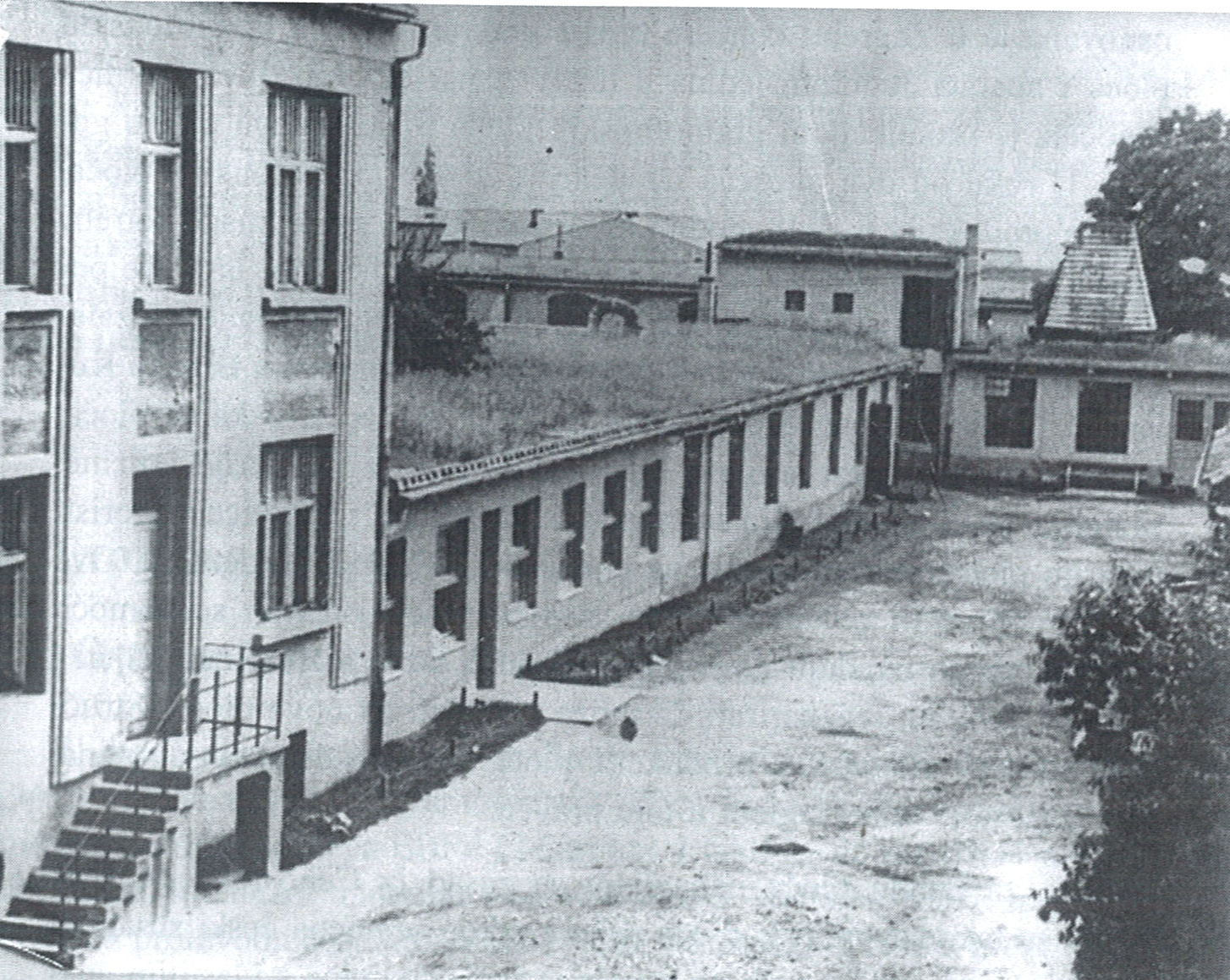 The first Jugoton Records HQ, located at Ilica 213, Zagreb. It subsequently moved to Dubrava, on the site where Croatia Records remains today © Photos from the book History of Vinyl Production in Croatia by Veljko Lipovšćak - provided by Croatia Records
The first Jugoton Records HQ, located at Ilica 213, Zagreb. It subsequently moved to Dubrava, on the site where Croatia Records remains today © Photos from the book History of Vinyl Production in Croatia by Veljko Lipovšćak - provided by Croatia Records
Of all the companies that issued music in the former Yugoslavia, Jugoton was the largest. Based in Dubrava, Zagreb, Jugoton was much more than the type of record label we know today - theirs was an entire industry of culture. Jugoton traces its roots all the way back to the 1930s when it began life as the Elektroton label. After the Second World War, the label was nationalized and renamed Jugoton.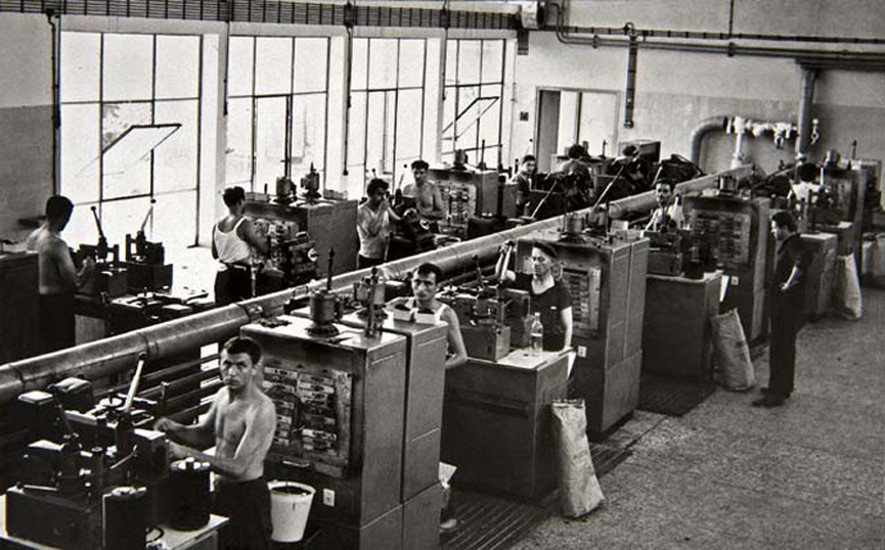
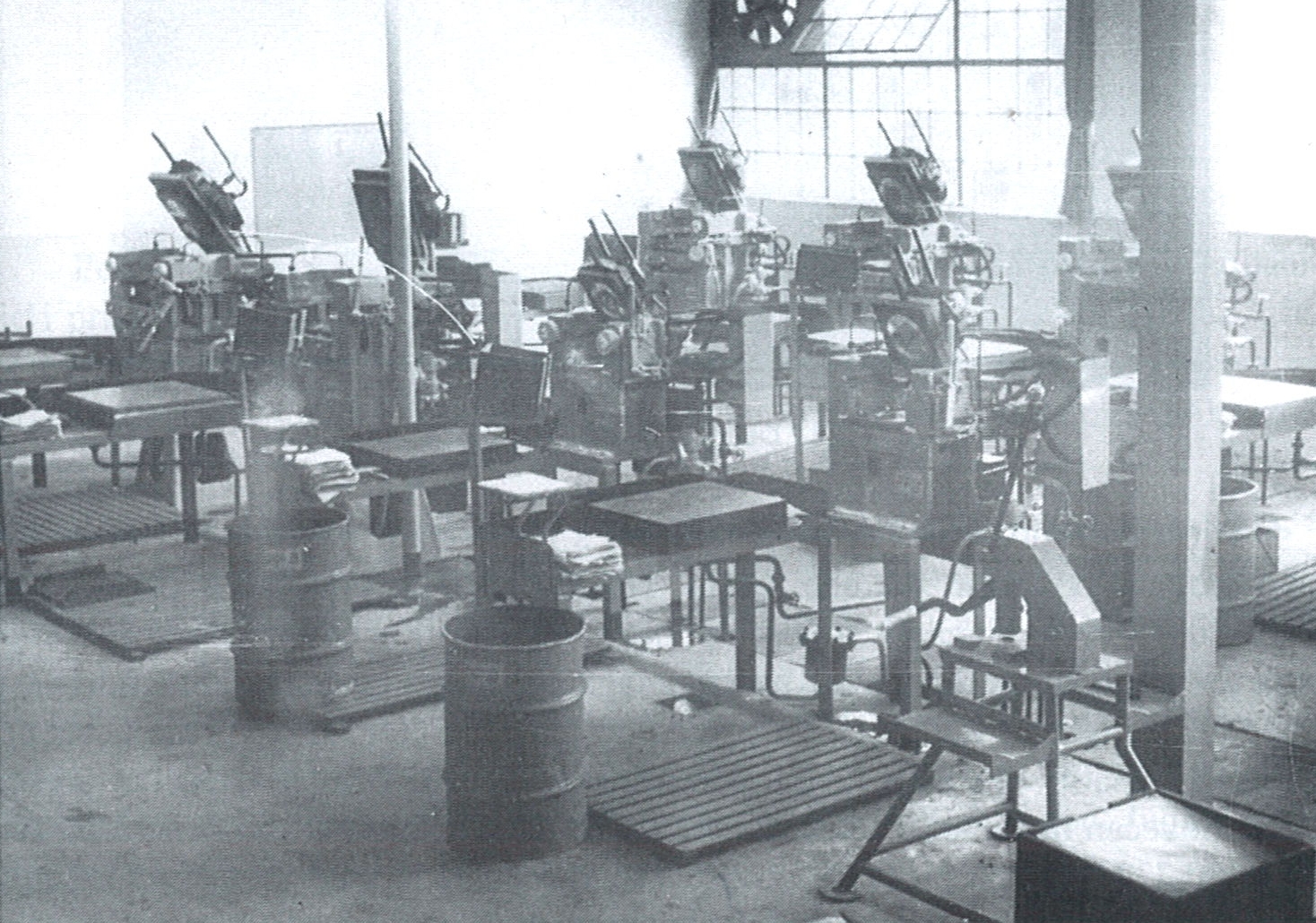 In the two photos above, we can see the Jugoton vinyl pressing factory at two different stages of its evolution © Photos from the book History of Vinyl Production in Croatia by Veljko Lipovšćak - provided by Croatia Records
In the two photos above, we can see the Jugoton vinyl pressing factory at two different stages of its evolution © Photos from the book History of Vinyl Production in Croatia by Veljko Lipovšćak - provided by Croatia Records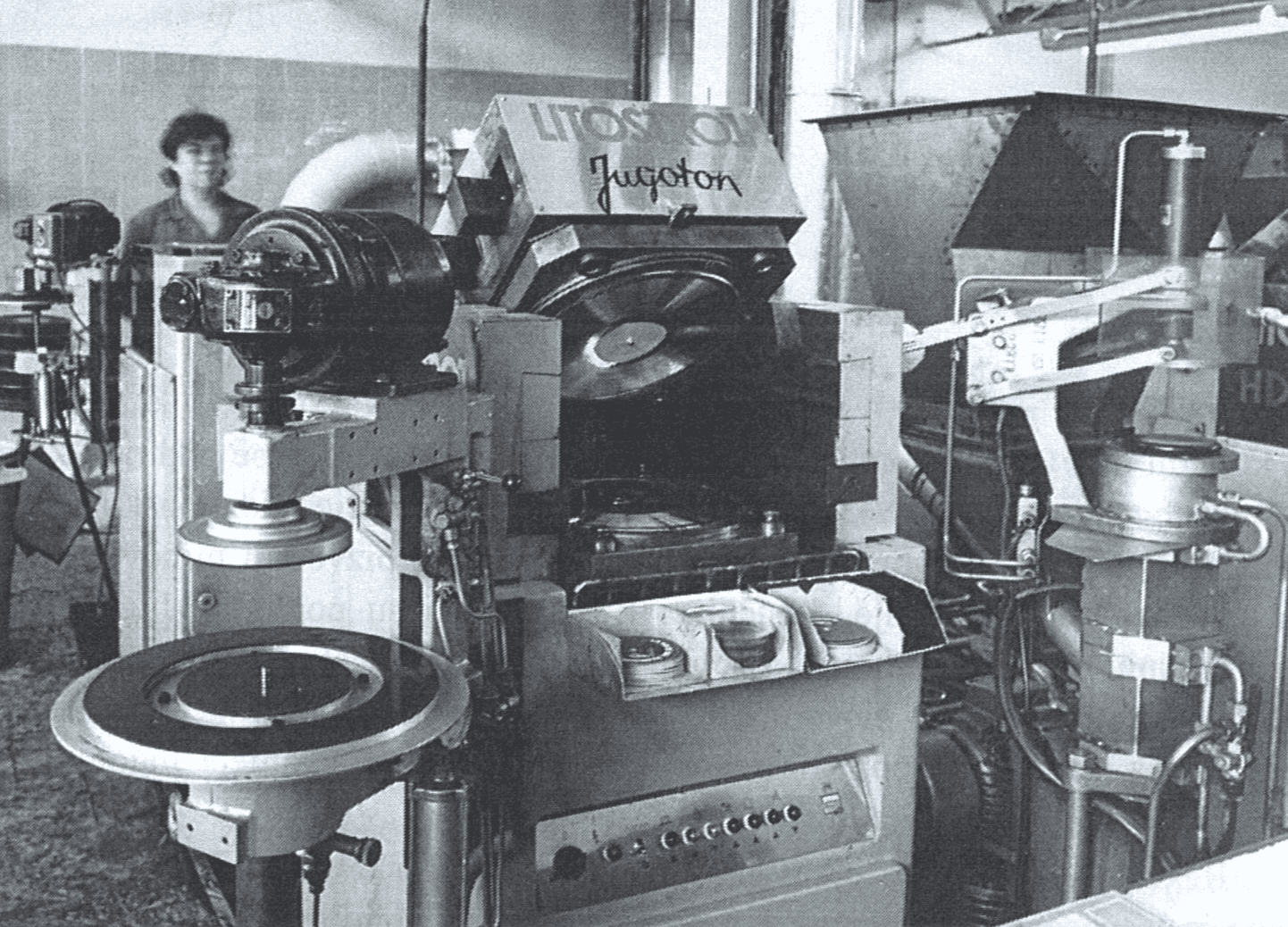 The hydraulic semi-automatic vinyl pressing machine 'Litostroj' at the Jugoton pressing plant 1967 - 1979 © From the book History of Vinyl Production in Croatia by Veljko Lipovšćak - provided by Croatia Records
The hydraulic semi-automatic vinyl pressing machine 'Litostroj' at the Jugoton pressing plant 1967 - 1979 © From the book History of Vinyl Production in Croatia by Veljko Lipovšćak - provided by Croatia Records
At the peak of its influence, Zagreb's Jugoton did more than just sign artists and release music. On the Dubrava site where Croatia Records now stands was a then ultra-modern production studio where famous artists from all over Yugoslavia would come and record. Jugoton made its own discs – at its peak, Jugoton's pressing plant churned out 30, 000 vinyl records every day. By 1982, its decade-old cassette production line made 20,000 units per day. They also owned the largest chain of music stores within the country. As well as the domestic artists signed to Jugoton, the label licensed and released music by some of the biggest artists of the day, including Elvis Presley, The Beatles, The Rolling Stones, Deep Purple and Pink Floyd. Its audience was the 20 million+ inhabitants of Yugoslavia.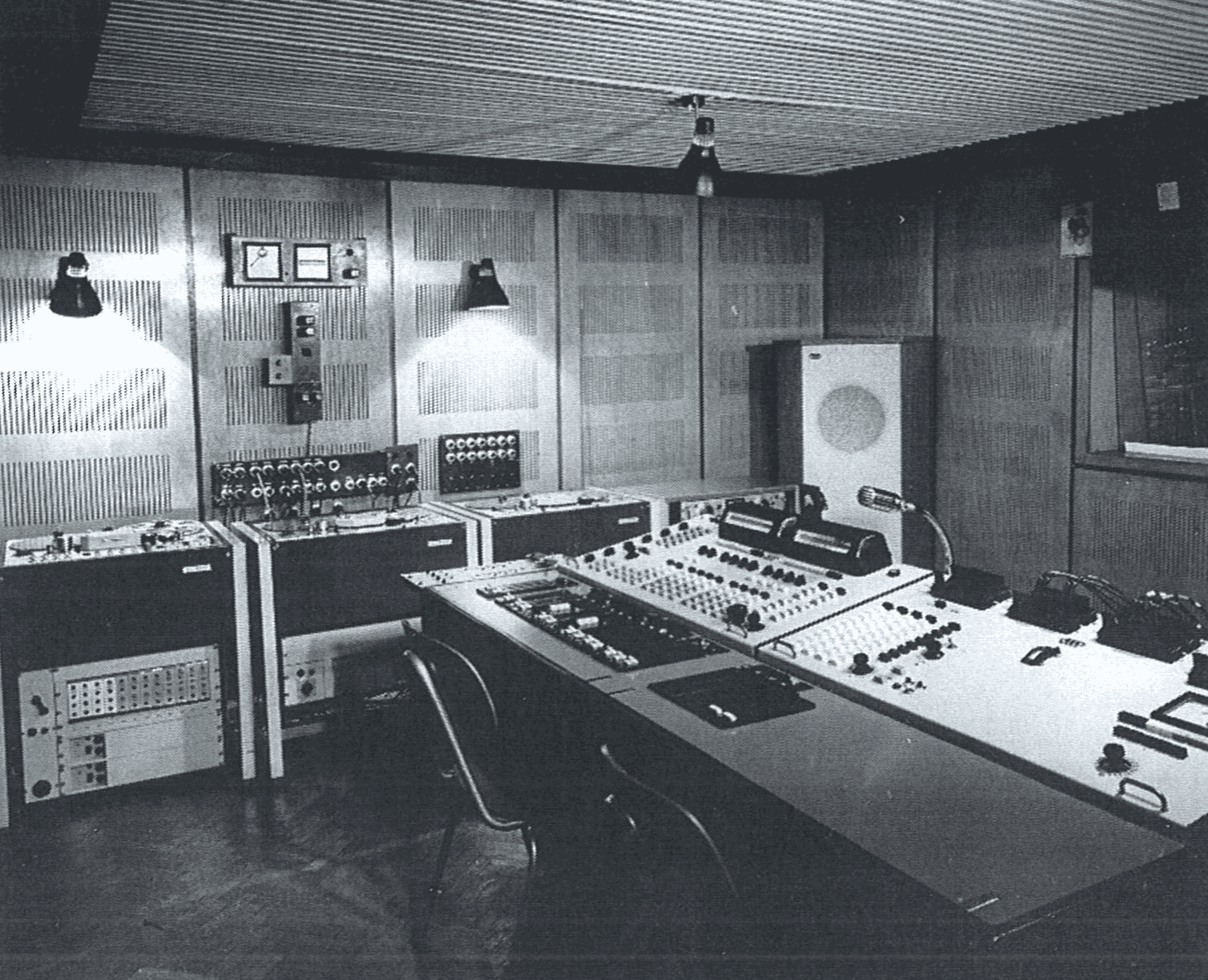 Part of the Jugoton studio set up on the Dubrava site. This specific equipment was in use between 1964 and 1975 © From the book History of Vinyl Production in Croatia by Veljko Lipovšćak - provided by Croatia Records
Part of the Jugoton studio set up on the Dubrava site. This specific equipment was in use between 1964 and 1975 © From the book History of Vinyl Production in Croatia by Veljko Lipovšćak - provided by Croatia Records
Though the music contained in Croatia Records Jugoton Funk Vol. 1 does not sound immediately like the folk and pop music we associate with the label, considering the size of the Croatia Records Jugoton archive it is perhaps less surprising that such anomalies can be found.
“Western music always had a strong appeal in Yugoslavia,” says Dr. Smeđi Šećer. “At the beginning of the communist regime, there was a strong implementation of censorship. But, in the 1960s the (communist) party seemed to relax and allow some western influences through. From this decade, a lot of cover versions of western artists started to be recorded by Yugoslavian singers. Yugoslavian labels would officially license western music and release it here. For instance, you can find releases by Ray Charles on the PGP-RTB label out of Belgrade from the early 1960s. All of this started to influence the music made here. Arsen Dedić, for example, recorded the first Yugoslavian bossa nova record in 1963.”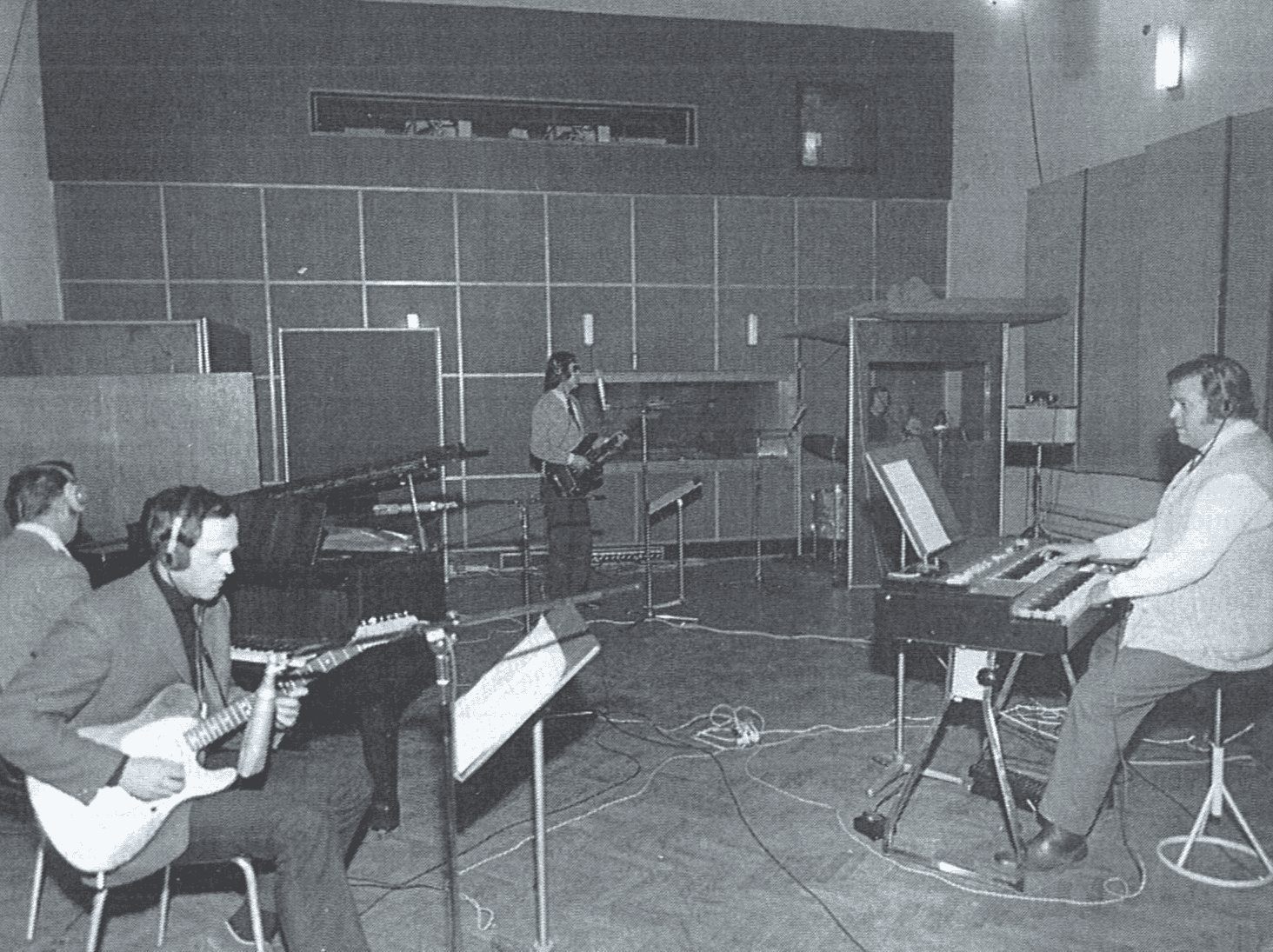 Zagreb musicians pictured at the small sound hall at Jadran film © From the book History of Vinyl Production in Croatia by Veljko Lipovšćak - provided by Croatia Records
Zagreb musicians pictured at the small sound hall at Jadran film © From the book History of Vinyl Production in Croatia by Veljko Lipovšćak - provided by Croatia Records
“The funk sound from here can be really interesting - quite unique. While some bands did try to record this black American music in exactly the style as the Americans did it, many artists from here enjoyed experimenting with the style - in particular some pop artists and progressive rock bands. They took the rhythm and the funk from the American music, but added their own styles – sometimes distinctly Balkan styles – over the top. Boki Milošević and the Belgrade Jazz Orchestra spring to mind immediately.”
Zdravko Čolić - Mujo kuje konja po mjesecu
A giant of Yugoslavian music, Zdravko Čolić's inclusion on Croatia Records Jugoton Funk Vol. 1 is one of the most unusual (and rarest) pieces of music in his back catalogue. It is a funk version of the Bosnian sevdah classic 'Mujo kuje konja po mjesecu (Mujo changes the horseshoe by the moonlight)'. “This is from an extremely rare compilation of pop festival music,” says Dr. Smeđi Šećer. “It's not something you'd come across every day. It was shown to me by a Slovenian DJ colleague. I only ever saw a physical copy of this release maybe two or three times in all my years spent digging.”
The world's largest exporter of music is the United States. The second-largest is the United Kingdom. That these two largest exporters share a common language – and it being one of the world's most widely spoken – is no coincidence. It can be difficult to export music from Croatia and other Balkan nations purely because of the language barrier. People like to understand the text of what they are listening to. Such barriers can be overcome with overtly emotional delivery, such as in the case of folk music like sevdah, but also when the musical style is something relevant to the dancefloor. Especially within a niche international scene like rare funk.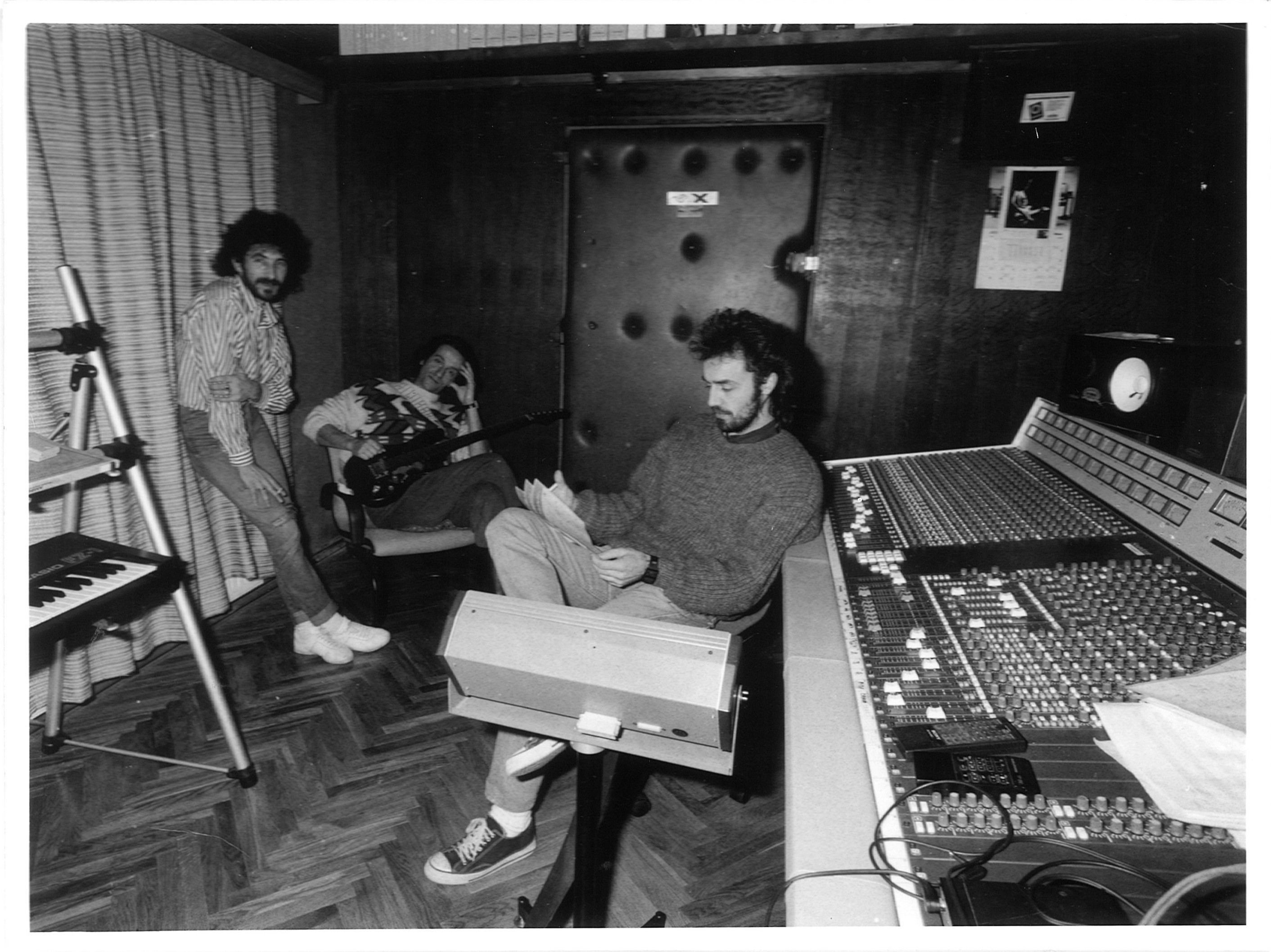 Even after the label stopped being Jugoton and became Croatia Records, famous artists from all the former countries of Yugoslavia would still come to work at the recording studios in Dubrava. In this photo from the early 1990s we see (left to right) Croatian singer Željko Bebek from the Sarajevo-formed Yugoslavian rock giants Bijelo Dugme, Macedonian guitar virtuoso Vlatko Stefanovski from the band Leb i sol and Bosnian singer, guitarist, arranger and producer Nikša Bratoš from the band Crvena Jabuka. Bijelo Dugme was the most popular and best-selling rock band from Yugoslavia. Their first recordings were offered to record label Diskoton in their native Sarajevo. They were turned down, allegedly as the label's release schedule was already full for the following six months. This is widely considered the greatest business mistake in the history of Yugoslav record publishing. On the same day as this refusal, Zagreb's Jugoton snapped the band up for an initial five-year contract © Photo from the Croatia Records archive and licensed for exclusive use within this article by Croatia Records
Even after the label stopped being Jugoton and became Croatia Records, famous artists from all the former countries of Yugoslavia would still come to work at the recording studios in Dubrava. In this photo from the early 1990s we see (left to right) Croatian singer Željko Bebek from the Sarajevo-formed Yugoslavian rock giants Bijelo Dugme, Macedonian guitar virtuoso Vlatko Stefanovski from the band Leb i sol and Bosnian singer, guitarist, arranger and producer Nikša Bratoš from the band Crvena Jabuka. Bijelo Dugme was the most popular and best-selling rock band from Yugoslavia. Their first recordings were offered to record label Diskoton in their native Sarajevo. They were turned down, allegedly as the label's release schedule was already full for the following six months. This is widely considered the greatest business mistake in the history of Yugoslav record publishing. On the same day as this refusal, Zagreb's Jugoton snapped the band up for an initial five-year contract © Photo from the Croatia Records archive and licensed for exclusive use within this article by Croatia Records
“Quite a few of these records are well known among connoisseur collectors outside of ex-Yu countries and they have a high price,” says Dr. Smeđi Šećer. “You can find Yugoslavian funk included on mixtapes by rare funk and hip hop collector DJs from all over the world. I know of one mixtape made by a well-known DJ from New York which uses only music released in the former Yugoslavia. And why shouldn't that be the case? This is the era we live in. You can go out in Zagreb and hear a Croatian DJ play Peruvian psychedelic cumbia music or afrofunk, so there are definitely DJs in the UK, the USA - maybe even Peru - who will play Yugoslavian funk. It's just feel-good dancefloor music that transcends all boundaries.”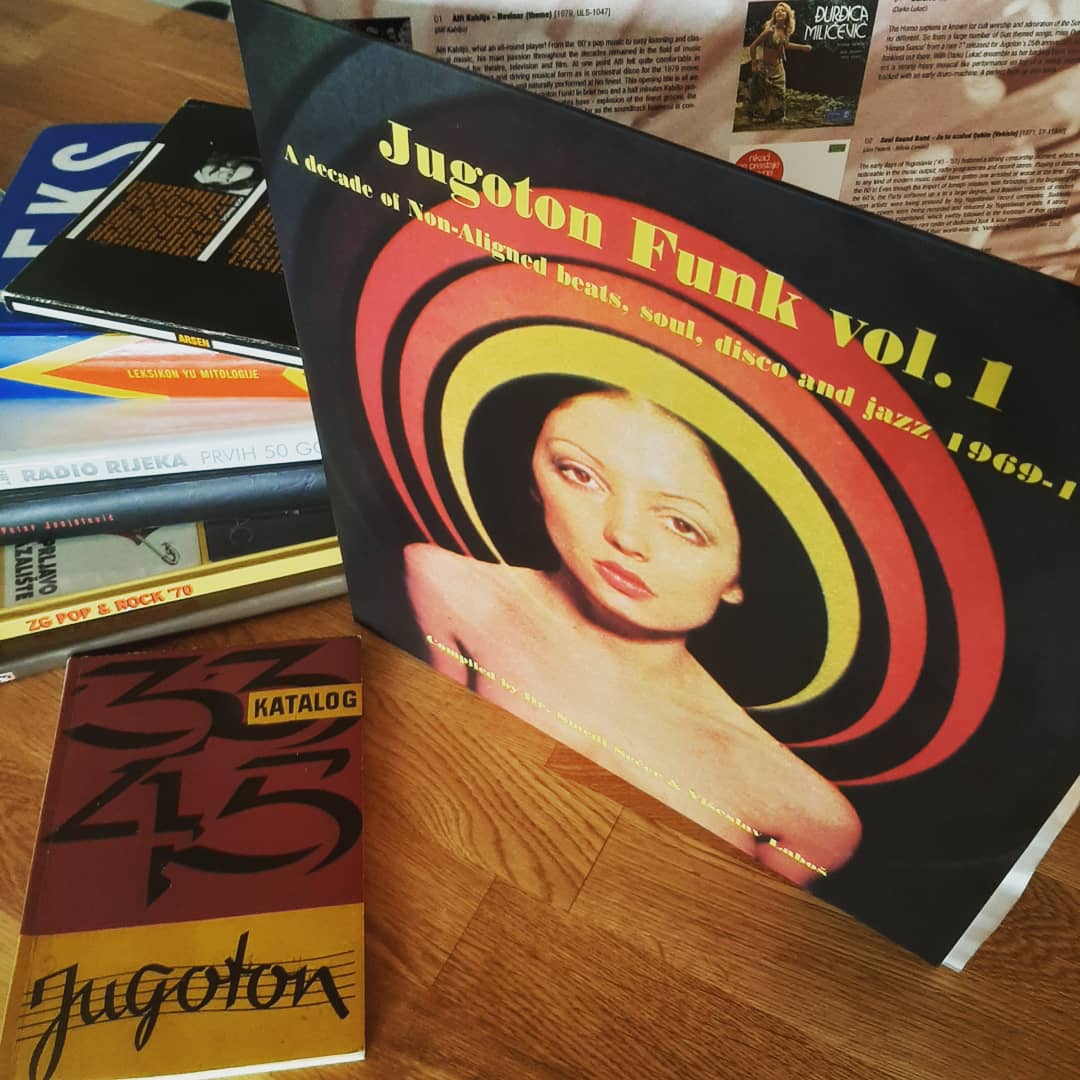
The digital and CD version of Croatia Records Jugoton Funk Vol. will be released shortly by Croatia Records. The extravagantly designed double vinyl album version is out now and was released under license by specialist Dutch vinyl company Everland Music. The last vinyl album produced by Jugoton’s vinyl pressing plant in Croatia was a disc containing the sermons of Pope John Paul II
For the latest travel info, bookmark our main travel info article, which is updated daily.
Read the Croatian Travel Update in your language - now available in 24 languages.
Coronafund: ZAMP Will Help Croatian Musicians During Pandemic
As Novac/Zlatko Simic writes on the 4th of July, 2020, Milan Majerovic-Stilinovic, head of communications at HDS ZAMP, spoke to Jutarnji list about the coronafund for musicians.
Judging by the performances of musicians, the coronavirus pandemic has brought this industry to its knees. Both the known and the unknown have their respective existential worries. What does ZAMP’s data on revenue decline from March to July say?
The figures aren't good, because they reflect the situation in which the entire music industry finds itself both here in Croatia and across the world: the total revenues of HDS ZAMP from all sources already fell by 30 percent in March this year when compared to March last year. April was even worse, with the absence of music events and the absence of payment for music licenses for most business users, the drop in revenue compared to April 2019 was as much as 72 percent. During June, the situation improved, but it's still impossible to be optimistic.
But radio stations and television channels still see the performances of Croatian artists. Where are the biggest losses?
They refer to those users who didn't work during the lockdown and didn't even receive any music license bills. Along with the cafes, clubs, restaurants and hotels, the biggest losses come from the concert industry. This year there are no big summer festivals, concerts in arenas, there are almost no city events and there aren't really even any weddings or similar smaller events... Of course, it isn't only the songwriters who are affected, but also the whole chain, from the performers, concert organisers and promoters, lighting technicians... Everyone's hands are tied because of this situation until further notice.
What measures have you taken to assist your members in receiving payment from the three aid packages?
The Croatian Society of Composers paid its members a total of 800,000 kuna in the form of aid from the Solidarity Fund, which otherwise, on an annual basis, amounts to 50,000 kuna. This speaks volumes about the seriousness with which the HDS approached the crisis: this amount was distributed to a total of 90 regular and associate members, ie, those most affected by the coronavirus crisis, as well as those who suffered damage during the Zagreb earthquake.
The public was quite appalled by some of the names asking for help. By what criteria were the most vulnerable members selected?
First of all, regular members of the society were helped, all 36 of them, who suffered significant losses or damage during the earthquake due to the inability to conduct their business, which they proved when applying for the tender with records, personal statements, etc. 54 associate members of the society, in accordance with their asset and family status, also received help from us. HDS has only seriously considered applications from people who see music authorship as an important source of their income in life, not just an occasional occupation.
Now concerts and summer tours are being postponed again, and even in the campaign it wasn't possible to sing. Bands and singers who make their living from concerts are in the most difficult position. How else can ZAMP help them?
The real losses will be known in autumn when many, including musicians, will feel a decline in their income. HDS ZAMP is preparing a special ''coronafund'' for this period, and is actively working on the monetisation of online content to monitor the transition from real stages to virtual ones. We're monitoring all funds and sources of help for creatives, so we're inform our members about them, and we're also helping out legally.
A small number of songwriters live well on royalties. Did any of these famous names remember their colleagues who sang their songs and set up a special aid fund for them out of solidarity?
The performers were taken care of quickly and correctly by their umbrella association, the Croatian Music Union, through its funds and tenders.
You've been in this industry for years, how do you explain that after so many concerts, sold records and performances in the diaspora and at weddings, many don't even have any money in their socks after a couple of months?
That's nothing new, just like other industries, some musicians are skilled entrepreneurs who will make ten kuna from one kuna tomorrow, and some spend everything on the way out of the bar where they earned it. In recent years, the situation has been very favourable for most musicians, various types and forms of music have been used more and more, tourism has grown, and with it, the entertainment industry has too. No one even thought that such a tectonic disturbance could possibly occur.
But I read on your website that 23 songs are submitted daily, and the activity during the coronavirus pandemic increased by 45 percent when compared to last year. What does all that mean?
This means that most of them still used isolation creatively, either for bursts of inspiration or for arranging and finishing the songs that were sitting in the drawer. I hope that this will be one of the positive aspects of this situation and that they will satisfy the artistic needs of the audience, but also the material needs of their authors, once the music business starts up again in full force.
What's the situation in the countries around us, including in the EU?
The situation in Croatia is still significantly better than it is in most other countries, especially in those in our immediate region. For example, despite all of the challenges of doing business in the middle of a pandemic, HDS ZAMP successfully realised as many as two royalty calculations in April and June. These amounts have helped many authors to overcome the crisis period more easily, although we, like other countries and societies in the region, are facing a difficult winter period and a significant drop in revenue, perhaps 50 million kuna in total.
As a longtime journalist, what do you miss about your old job? I'd bet you're making a documentary about the Croatian music industry?
You'd lose that bet, but you're not far wrong - I've been hiking a lot in recent years and spending time in nature. So, just today my first book ''What I Learned on the Mountain'' came out. It contains 50 short ''stories in progress''. In musical terms, I don’t know if the book will be a hit, I'd be happy for it to become and remain a slow-burning evergreen.
For more on the coronafund and life during the coronavirus pandemic in Croatia, follow our lifestyle page.


